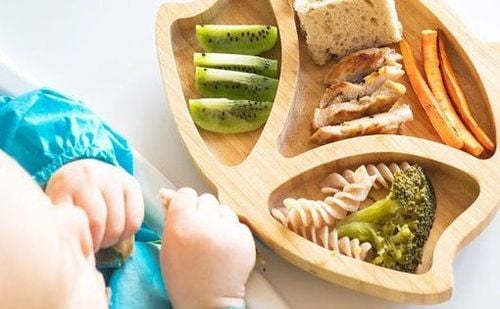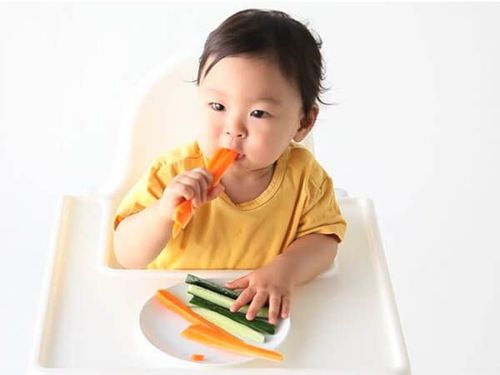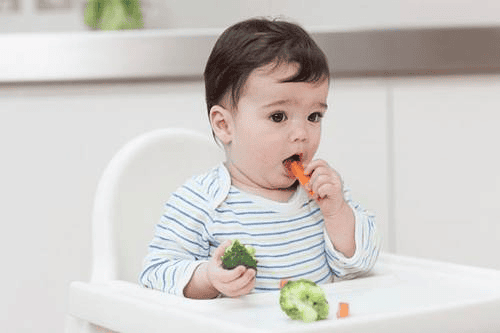This is an automatically translated article.
The article is professionally consulted by Specialist Doctor II Le Thanh Cam - Pediatrician - Pediatrics - Neonatology - Vinmec Danang International General HospitalSelf-directed weaning (BLW) is a method of weaning that is commonly applied by mothers today in the process of raising children. However, this method has a lot to do with the baby's motor ability, so it can't be applied at all ages. So when can we apply self-directed weaning? Can BLW baby food be used for 5 months old baby?
1. What is self-directed weaning?
Baby Led Weaning (BLW) is a method of weaning that allows children to decide on their own food, how to eat according to their own preferences and parents must respect this decision of the child.
Self-directed weaning can help stimulate the child's development to be more favorable in all aspects, especially movement, flexibility and handling as well as access to food.
No matter how babies are introduced to solids by any method, the following factors need to be ensured:
Breast milk is still the most important source of nutrition at this time; Eat enough 4 food groups: starch, protein, fat, vitamins and minerals. In the same group of substances, there should be many different foods to help children have a variety of tastes; Eat the amount gradually increased from less to more, starting from thin then thickening then thickening. Eat from smooth to coarse; Feed the baby at the right age, in terms of methods, ways of eating and dishes; Teach your baby the habit of eating at the right time. Should eat together with the family, eat together and should not give children snacks before meals; Especially, do not force children to eat too much or eat foods that they do not like.
2. When can self-directed weaning be applied to children?
According to the recommendations of the World Health Organization (WHO), the most appropriate time to introduce solid foods for babies is from 6 months old because at this time, the baby's digestive system has fully developed, so it can absorb solid foods. and more complex substances than breast milk. At this time, babies also need to be provided with nutrients from complementary foods that breast milk cannot provide enough to ensure the body can develop healthy.
Có thể áp dụng ăn dặm tự chỉ huy cho trẻ từ 6 tháng tuổi
Moreover, at the age of 5 months, the gross motor of the child is not yet firm and perfected, some children are still not able to sit firmly, not yet flexible fingers to grasp and put in the mouth. In 5-month-old children, the child's movement is inclined to keep the neck straight and turn the head when sitting, the child can firmly sit for about 30 minutes, the grasping activities are not yet mastered. Therefore, the application of BLW weaning to 5-month-old children sometimes encounters many difficulties, which can cause choking or choking on food for children. If breastfeeding can be guaranteed, it is best to exclusively breastfeed until 6 months of age.
According to observational research, 87% of babies from 6-7 months old begin to have the skill of grasping food with their hands, but by the 7th-8th month, this skill increases to 96%. Therefore, most babies at 6 months old can eat on their own.
3. Signs that your baby is ready for solid foods
The baby's weight rapidly changes, can double compared to the time at birth; Children are more flexible in neck movements such as keeping their heads straight, can sit to eat by themselves; Children are flexible in mouth movements in opening and receiving food when being fed by adults; Children know how to express their likes or dislikes in foods. A simple example is the act of turning away, refusing to open your mouth to a food that the child does not like; Weaning can be divided into the following stages: 4 - 6 months old: you can start to feed your baby solids with pureed porridge or cook powdered porridge for the baby in the first week. Then start feeding with easy-to-digest vegetables but pay attention to all puree; From 6 months of age: give the child to eat diluted cooked powder, eat in small meals. Then gradually give solid food; 7-8 months: You can start giving your baby a little thicker cooked powder; 9-10 months old: porridge eating stage;

Trẻ từ 9-10 tháng tuổi: giai đoạn ăn cháo
12-18 months: this period begins weaning, so divide the meal into 3 main meals and 2 snacks; When the child has enough teeth: at this stage, the child can eat rice. Self-directed weaning is not optimal for all ages, especially in babies 5 months of age or younger. However, for the best time and way of self-directed weaning for your child, contact your doctor for advice on the most appropriate method and diet for your child.
For children to be healthy and develop well, it is necessary to have a nutritious diet in terms of quantity and quality balance. If children are not provided with adequate and balanced nutrients, it will lead to diseases of excess or lack of nutrients, which adversely affect the comprehensive development of children in terms of physical, mental and motor skills.
The period of baby eating solid foods is an extremely important period to help children develop comprehensively. Children who do not eat properly are at risk of micro-mineral deficiencies, causing anorexia, growth retardation, malabsorption, etc. If they notice the above signs, parents should supplement their children with supportive products. The supplement contains lysine, essential micro-minerals and vitamins such as zinc, chromium, selenium, and B vitamins to help fully meet the nutritional needs of children. At the same time, these essential vitamins also support digestion, enhance nutrient absorption, help improve anorexia, and help children eat well.
Parents can learn more:
Signs of zinc deficiency in children
Micronutrient deficiency and failure to gain weight in children
Please regularly visit Vinmec.com website and update useful information to take care of your child. Take care of the baby and the whole family.














